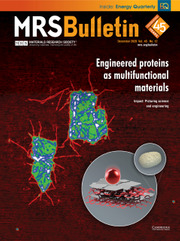Crossref Citations
This article has been cited by the following publications. This list is generated based on data provided by
Crossref.
Pöhls, Jan-Hendrik
Johnson, Michel B.
White, Mary Anne
Malik, Rachit
Ruff, Brad
Jayasinghe, Chaminda
Schulz, Mark J.
and
Shanov, Vesselin
2012.
Physical properties of carbon nanotube sheets drawn from nanotube arrays.
Carbon,
Vol. 50,
Issue. 11,
p.
4175.
Jakubinek, Michael B.
Johnson, Michel B.
White, Mary Anne
Jayasinghe, Chaminda
Li, Ge
Cho, Wondong
Schulz, Mark J.
and
Shanov, Vesselin
2012.
Thermal and electrical conductivity of array-spun multi-walled carbon nanotube yarns.
Carbon,
Vol. 50,
Issue. 1,
p.
244.
LI, WEIFENG
BULMER, JOHN
RUFF, BRAD
SONG, YI
SALUNKE, PRAVAHAN
SHANOV, VESSELIN
and
SCHULZ, MARK J.
2013.
MODELING THE ELECTRICAL IMPEDANCE OF CARBON NANOTUBE RIBBON.
Nano LIFE,
Vol. 03,
Issue. 02,
p.
1350002.
Malik, Rachit
Song, Yi
Alvarez, Noe
Ruff, Brad
Haase, Mark
Suberu, Bolaji
Gilpin, Andrew
Schulz, Mark
and
Shanov, Vesselin
2013.
Atmospheric Pressure Plasma Functionalization of Dry-spun Multi-walled Carbon Nanotubes Sheets and its application in CNT-Polyvinyl Alcohol (PVA) Composites.
MRS Proceedings,
Vol. 1574,
Issue. ,
Ganguli, Sabyasachi
Reed, Amber
Jayasinghe, Chaminda
Sprengard, Joe
Roy, Ajit K.
Voevodin, Andrey A.
and
Muratore, Chris
2013.
A simultaneous increase in the thermal and electrical transport in carbon nanotube yarns induced by inter-tube metallic welding.
Carbon,
Vol. 59,
Issue. ,
p.
479.
Shanov, Vesselin
Cho, Wondong
Malik, Rachit
Alvarez, Noe
Haase, Mark
Ruff, Brad
Kienzle, Nicholas
Ochmann, Timothy
Mast, David
and
Schulz, Mark
2013.
CVD growth, characterization and applications of carbon nanostructured materials.
Surface and Coatings Technology,
Vol. 230,
Issue. ,
p.
77.
Ruff, Brad
Li, Weifeng
Venkatasubramanian, Rajiv
Mast, David
Sowani, Anshuman
Schulz, Mark
and
Harned, Timothy J.
2014.
Nanotube Superfiber Materials.
p.
595.
Song, Yi
Suberu, Bolaji
Shanov, Vesselin
and
Schulz, Mark
2014.
Nanotube Superfiber Materials.
p.
627.
Abot, Jandro L.
Alosh, Tareq
and
Belay, Kalayu
2014.
Strain dependence of electrical resistance in carbon nanotube yarns.
Carbon,
Vol. 70,
Issue. ,
p.
95.
Zhao, Daoli
Guo, Xuefei
Wang, Tingting
Alvarez, Noe
Shanov, Vesselin N.
and
Heineman, William R.
2014.
Simultaneous Detection of Heavy Metals by Anodic Stripping Voltammetry Using Carbon Nanotube Thread.
Electroanalysis,
Vol. 26,
Issue. 3,
p.
488.
Hoyos-Palacio, L M
García, A G
Pérez-Robles, J F
González, J
and
Martínez-Tejada, H V
2014.
Catalytic effect of Fe, Ni, Co and Mo on the CNTs production.
IOP Conference Series: Materials Science and Engineering,
Vol. 59,
Issue. ,
p.
012005.
Hehr, Adam
Song, Yi
Suberu, Bolaji
Sullivan, Joe
Shanov, Vesselin
and
Schulz, Mark
2014.
Nanotube Superfiber Materials.
p.
671.
Jakubinek, Michael B.
2014.
Nanotube Superfiber Materials.
p.
425.
Koo, Youngmi
Malik, Rachit
Alvarez, Noe
White, Leon
Shanov, Vesselin N.
Schulz, Mark
Collins, Boyce
Sankar, Jagannathan
and
Yun, Yeoheung
2014.
Aligned carbon nanotube/copper sheets: a new electrocatalyst for CO2reduction to hydrocarbons.
RSC Adv.,
Vol. 4,
Issue. 31,
p.
16362.
Keller, Steven D.
Zaghloul, Amir I.
Shanov, Vesselin
Schulz, Mark J.
Mast, David B.
and
Alvarez, Noe T.
2014.
Radiation Performance of Polarization Selective Carbon Nanotube Sheet Patch Antennas.
IEEE Transactions on Antennas and Propagation,
Vol. 62,
Issue. 1,
p.
48.
Yue, Yanan
Liu, Kang
Li, Man
and
Hu, Xuejiao
2014.
Thermal manipulation of carbon nanotube fiber by mechanical stretching.
Carbon,
Vol. 77,
Issue. ,
p.
973.
Koo, Youngmi
Shanov, Vesselin N.
Yarmolenko, Sergey
Schulz, Mark
Sankar, Jagannathan
and
Yun, Yeoheung
2015.
Inverse-Ordered Fabrication of Free-Standing CNT Sheets for Supercapacitor.
Langmuir,
Vol. 31,
Issue. 27,
p.
7616.
GOKTEPE, Fatma
2015.
Spinnable Carbon Nanotubes and Technical Yarns Produced by These Special Fibers.
Tekstil ve Mühendis,
Vol. 22,
Issue. 100,
p.
1.
Abot, Jandro L
Kiyono, César Y
Thomas, Gilles P
and
Silva, Emílio C N
2015.
Strain gauge sensors comprised of carbon nanotube yarn: parametric numerical analysis of their piezoresistive response.
Smart Materials and Structures,
Vol. 24,
Issue. 7,
p.
075018.
Anike, Jude
Bajar, Angeline
and
Abot, Jandro
2016.
Time-Dependent Effects on the Coupled Mechanical-Electrical Response of Carbon Nanotube Yarns under Tensile Loading.
C,
Vol. 2,
Issue. 1,
p.
3.


